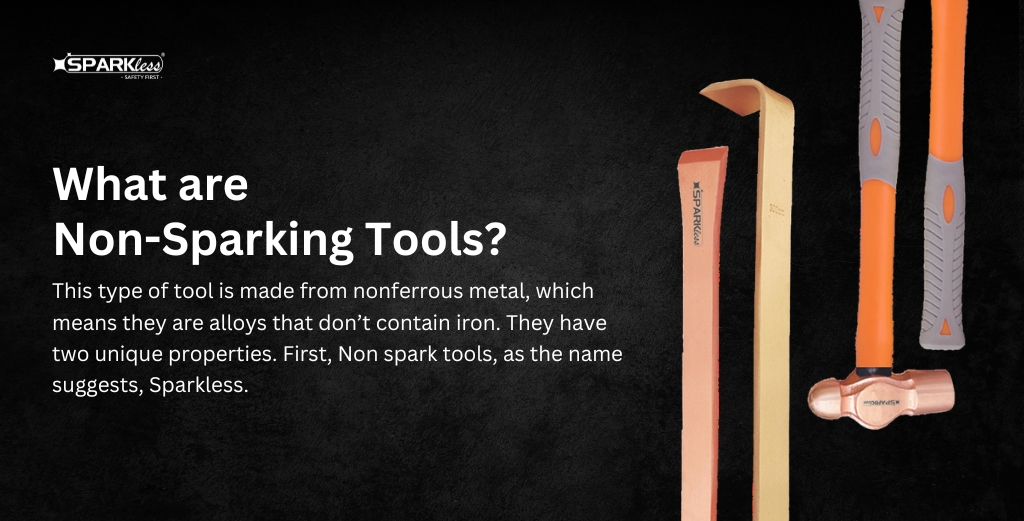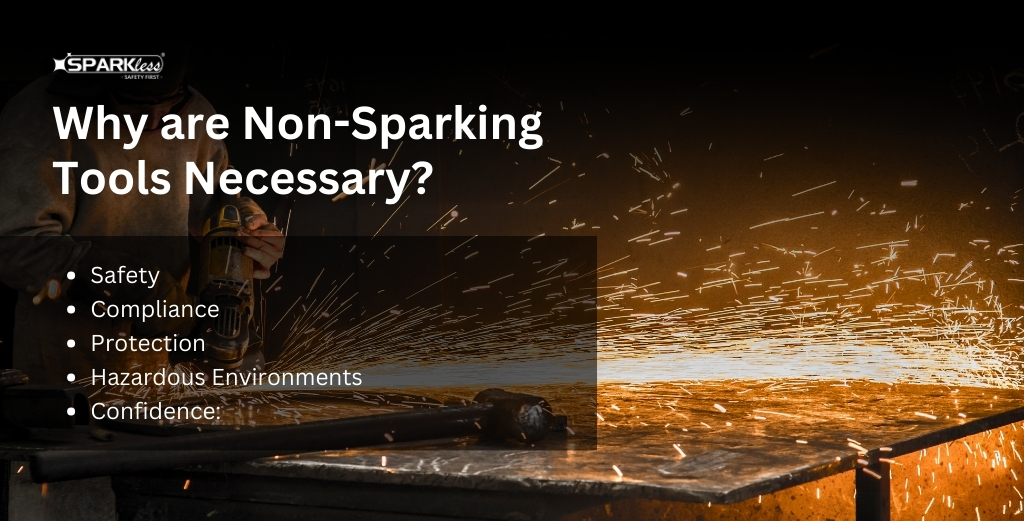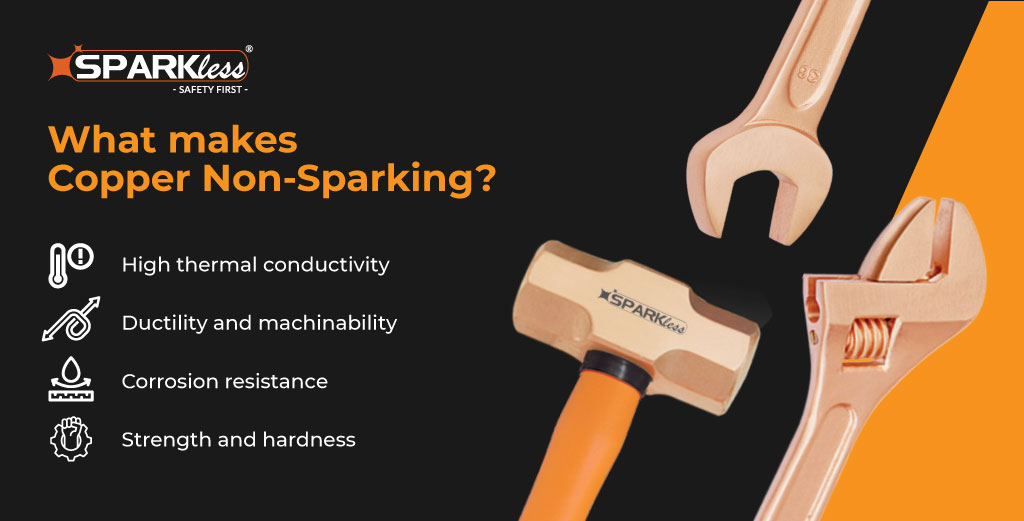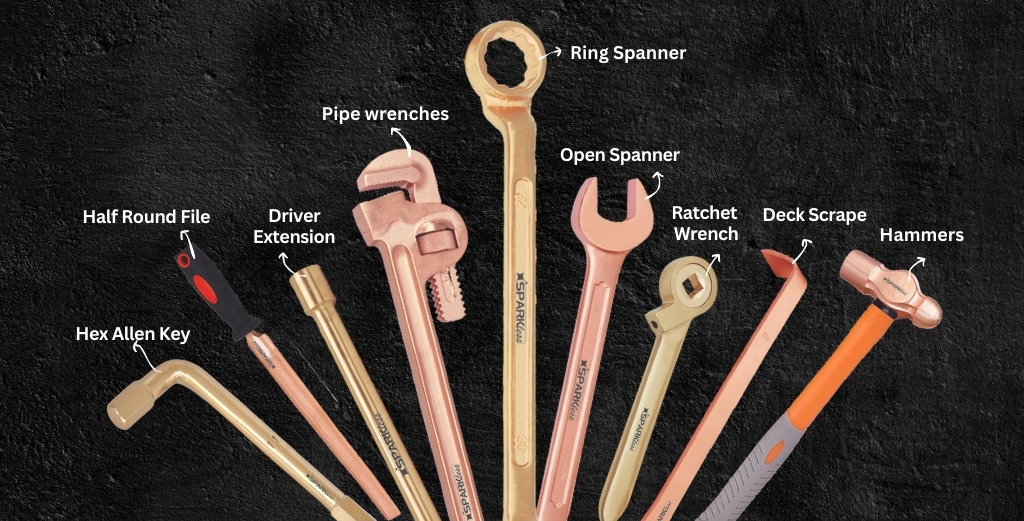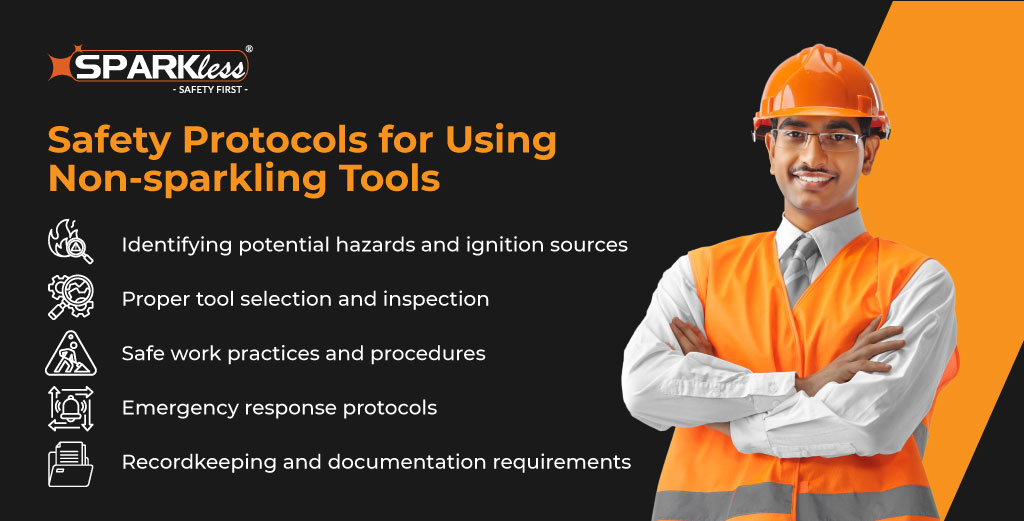
How Do Non-Sparking Tools Work? An In-Depth Look
Non-sparking tools, also known as spark-resistant or spark-proof tools, are essential in environments where the presence of flammable gasses, vapors, or combustible dusts poses a significant risk of ignition. These specialized tools are designed to prevent the generation of incendiary sparks that could potentially ignite hazardous materials, leading to devastating explosions or fires.
The importance of using non-sparking tools cannot be overstated, particularly in industries such as oil and gas, mining, aviation, and others where the consequences of an accident can be catastrophic. This blog post will delve into the intricacies of how non-sparking tools work, exploring their construction, working principles, and the critical role they play in enhancing safety in hazardous environments.
What are Non-Sparking Tools?
Non-sparking tools are specialized equipment made from non-ferrous metals or non-metallic materials, such as aluminum, beryllium, copper, or certain types of plastic. Unlike traditional ferrous tools (those containing iron), these tools are designed to minimize the risk of generating sparks that could ignite flammable substances.
The primary purpose of non-sparking tools is to provide a safe alternative for various operations in potentially explosive atmospheres. These environments can be found in numerous industries, including:
- Oil and gas exploration, production, and refining
- Mining operations
- Aviation maintenance and repair
- Chemical processing plants
- Pharmaceutical manufacturing facilities
In these settings, even a tiny spark caused by the friction between ferrous metals or the impact of a regular tool against a surface can have catastrophic consequences.
Since 1980, Bombay Tools has been a leading supplier of high-quality non-sparking, non-magnetic tools. Our extensive range of safety hand tools is renowned for their unmatched strength and durability. From non-sparking wrenches, ratchets, and sockets to hammers, axes, screwdrivers, pliers, and more, our catalog offers a diverse selection of essential safety equipment.
Learn more about Non Sparking Tools FAQ's
The use of non-sparking tools is crucial in hazardous environments due to the inherent risks associated with using regular ferrous tools. When ferrous metals come into contact with each other or strike a hard surface, they can generate sparks that reach temperatures exceeding 1,000°C (1,832°F). These high-temperature sparks have the potential to ignite flammable gases, vapors, or combustible dusts, leading to devastating explosions or fires.
Unfortunately, history is replete with examples of accidents caused by sparks from conventional tools in hazardous environments. One notable incident occurred in 2010 at the Deepwater Horizon oil rig in the Gulf of Mexico, where a spark ignited a massive gas leak, resulting in a catastrophic explosion that claimed 11 lives and caused an environmental disaster of epic proportions.
To avoid such tragic incidents, the use of non-sparking tools has become a mandatory safety measure in numerous industries, ensuring the utmost precautions are taken to mitigate the risk of ignition and protect workers, equipment, and the environment.
The Working Principle of Non-Sparking Tools
The primary working principle behind non-sparking tools lies in the properties of the materials used in their construction. These tools are made from non-ferrous metals or non-metallic materials that are less likely to generate incendiary sparks when struck against another surface or when subjected to friction.
The element Copper possesses excellent thermal conductivity. This allows it to absorb the energy (heat) that is generated during friction between copper and a very hard material. This absorption of energy by copper ensures that sparks do not have high energy and result in what is called cold sparks, making the alloy non-sparking.
What makes copper suitable for non-sparking tools?
The three key reasons that make copper ideal as a non-sparking tool are:
- High thermal conductivity: Copper has 3-5 times higher thermal conductivity compared to steel, allowing it to quickly dissipate the heat generated from friction.
- Ductility and machinability: Copper alloys like beryllium copper and aluminum bronze are ductile, weldable, and machinable, making them suitable for creating non-sparking tools
- Corrosion resistance: Copper alloys have good resistance to corrosion, allowing them to withstand harsh environments and maintain their non-sparking properties.
- Strength and hardness: Copper alloys like beryllium copper can be heat-treated to achieve strength and hardness comparable to steel, making them durable for use as non-sparking tools
In summary, the combination of copper's high thermal conductivity, ductility, corrosion resistance, and ability to be heat-treated for strength makes it an ideal material for creating non-sparking tools
Certain types of plastics, such as polyvinyl chloride (PVC) or nylon, are also used in the construction of non-sparking tools. These non-metallic materials are highly resistant to generating sparks, providing an additional layer of safety in hazardous environments.
It's important to note that while non-sparking tools significantly reduce the risk of ignition, they do not entirely eliminate it. Proper safety protocols, training, and maintenance practices must be followed to ensure the safe and effective use of these tools.
Types of Non-Sparking Tools
Non-sparking tools come in a wide range of categories and designs, catering to various applications and industries. Some of the most common types include:
- Wrenches (open-ended, box-end, adjustable)
- Pliers (slip-joint, lineman's, diagonal cutters)
- Hammers (ball-peen, sledge, mallets)
- Screwdrivers (flathead, Phillips, Torx)
- Chisels and punches
- Sockets and ratchets
- Shears and snips
- Pipe wrenches and tubing tools
These tools are often identified by their distinct colors, such as blue, green, or red, which serve as a visual cue for their non-sparking properties. Additionally, many non-sparking tools feature ergonomic designs and textured grips to ensure a secure and comfortable grip, even in challenging environments.
It's important to note that while these tools are designed to be non-sparking, they should never be used in conjunction with ferrous tools or struck against ferrous surfaces, as this could compromise their safety features.
Maintenance and Care of Non-Sparking Tools
Proper maintenance and care are crucial for ensuring the longevity and effectiveness of non-sparking tools. These tools are often subjected to harsh conditions and must be regularly inspected for signs of wear, damage, or corrosion.
Regular cleaning is essential to remove any debris, dirt, or contaminants that could potentially compromise the tool's performance or create a safety hazard. Manufacturers typically provide specific guidelines for cleaning and maintaining non-sparking tools, which should be followed diligently.
It's also important to store non-sparking tools in a clean, dry environment, away from excessive moisture or humidity, as these conditions can lead to corrosion or degradation of the tool's materials.
If a non-sparking tool becomes damaged or worn beyond repair, it should be immediately replaced to maintain the highest level of safety. Using damaged or compromised tools in hazardous environments can have severe consequences and should never be risked.
Safety Protocols for Using Non-Sparking Tools
While non-sparking tools are designed to minimize the risk of ignition in hazardous environments, their safe and effective use relies heavily on adhering to proper safety protocols and procedures. Comprehensive training and strict adherence to these protocols are essential for ensuring the safety of workers, equipment, and the surrounding environment.
One of the primary safety protocols involves the mandatory use of personal protective equipment (PPE) when working in hazardous areas. This may include flame-resistant clothing, safety glasses, hard hats, and respiratory protection, depending on the specific hazards present in the work area.
In addition to PPE, workers must receive thorough training on the correct handling, use, and maintenance of non-sparking tools. This training should cover topics such as:
- Identifying potential hazards and ignition sources
- Proper tool selection and inspection
- Safe work practices and procedures
- Emergency response protocols
- Recordkeeping and documentation requirements
It is also crucial to establish clear lines of communication and coordination among all personnel working in hazardous areas. This ensures that everyone is aware of potential risks and can take appropriate precautions to mitigate those risks.
Furthermore, strict adherence to safety protocols extends beyond the use of non-sparking tools. It encompasses a comprehensive approach to risk management, including regular inspections, maintenance of equipment, and adherence to industry-specific regulations and standards.
Advantages and Limitations of Non-Sparking Tools
The use of non-sparking tools offers several advantages in hazardous environments, primarily related to increased safety and reduced risk of accidents. Some of the key advantages include:
- Minimized risk of ignition: By eliminating the potential for incendiary sparks, non-sparking tools significantly reduce the likelihood of igniting flammable gases, vapors, or combustible dusts, thereby preventing catastrophic incidents.
- Enhanced worker safety: The use of non-sparking tools helps protect workers from the potential consequences of explosions or fires, reducing the risk of injuries or fatalities.
- Regulatory compliance: Many industries and regulatory bodies mandate the use of non-sparking tools in hazardous environments, ensuring adherence to safety standards and avoiding costly fines or penalties.
- Environmental protection: By preventing ignition incidents, non-sparking tools help mitigate the risk of environmental damage caused by fires, explosions, or the release of hazardous materials.
However, it's important to acknowledge that non-sparking tools also have some limitations:
- Higher cost: Non-sparking tools are typically more expensive than their ferrous counterparts due to the specialized materials and manufacturing processes involved.
- Limited availability: While the range of non-sparking tools continues to expand, certain specialized tools or equipment may not be readily available in non-sparking varieties.
- Potential for misuse: If not used correctly or in conjunction with ferrous tools, non-sparking tools can still pose a risk of ignition, highlighting the importance of proper training and adherence to safety protocols.
Despite these limitations, the advantages of non-sparking tools in hazardous environments far outweigh the potential drawbacks, making them an essential component of a comprehensive safety strategy.
Choosing the Right Non-Sparking Tools
With a wide range of non-sparking tools available in the market, selecting the appropriate tools for a specific application or environment is crucial. Here are some key factors to consider when choosing the right non-sparking tools:
- Material: The choice of material is perhaps the most critical factor. Non-sparking tools can be made from various materials, including aluminum, beryllium copper, brass, and certain types of plastic. Each material has its own strengths, limitations, and applications. For example, beryllium copper is known for its exceptional strength and hardness, making it suitable for heavy-duty applications, while aluminum is lightweight and corrosion-resistant, making it ideal for environments with potential chemical exposure.
- Size and weight: Non-sparking tools come in various sizes and weights, ranging from compact precision tools to heavy-duty wrenches and hammers. Consider the specific tasks and working conditions to ensure that the tools are comfortable to use and do not pose ergonomic risks or safety hazards.
- Ergonomics: Look for tools with ergonomic designs that provide a secure and comfortable grip, even in challenging environments. Features like textured handles, non-slip surfaces, and balanced weight distribution can help reduce fatigue and improve control.
- Application-specific requirements: Different industries and applications may have specific requirements or standards for non-sparking tools. For instance, the oil and gas industry may require tools with higher corrosion resistance, while the aviation industry may prioritize lightweight and compact designs.
- Compatibility: Ensure that the non-sparking tools you choose are compatible with the equipment, fasteners, and other components they will be used with. Incompatible tools can lead to inefficient work, damage, or safety issues.
- Certification and compliance: Many industries and regulatory bodies have specific certifications or compliance requirements for non-sparking tools used in hazardous environments. Ensure that the tools you choose meet these standards to avoid potential issues or violations.
It is highly recommended to consult with safety professionals, industry experts, or refer to relevant safety standards and guidelines when selecting non-sparking tools. Additionally, seeking advice from tool manufacturers or suppliers can provide valuable insights into the appropriate tools for your specific needs.
Conclusion
Non-sparking tools play a vital role in ensuring safety in hazardous environments where the presence of flammable gases, vapors, or combustible dusts poses a significant risk of ignition. By understanding the working principles, types, and proper use of these specialized tools, individuals and organizations can effectively mitigate the risk of devastating accidents and protect workers, equipment, and the environment.
Choosing the right non-sparking tools and adhering to proper safety protocols is essential for maintaining a safe and compliant work environment. Regularly inspecting and maintaining these tools, providing comprehensive training to personnel, and staying up-to-date with industry standards and regulations are all crucial components of an effective safety strategy.
Remember, the consequences of ignition incidents can be catastrophic, and the investment in non-sparking tools and safety measures is invaluable in preventing such occurrences. By prioritizing safety and embracing the use of non-sparking tools, we can create a safer and more secure working environment for all.
You can check out our wide range of non-sparking safety tools designed for various industries and applications.
FAQ
Q: What is the difference between non-sparking tools and regular tools? A: The main difference is that non-sparking tools are made from non-ferrous metals or non-metallic materials, such as aluminum, beryllium copper, or certain plastics. Unlike regular ferrous tools (containing iron), non-sparking tools are designed to minimize the risk of generating incendiary sparks that could ignite flammable substances in hazardous environments.
Q: In which industries are non-sparking tools commonly used? A: Non-sparking tools are essential in industries where flammable gases, vapors, or combustible dusts are present, such as oil and gas, mining, aviation, chemical processing, and pharmaceutical manufacturing.
Q: Can non-sparking tools still produce sparks? A: While non-sparking tools significantly reduce the risk of generating sparks, they do not entirely eliminate it. Proper use, maintenance, and adherence to safety protocols are crucial to ensure the safe operation of these tools.
Q: How can I identify non-sparking tools? A: Non-sparking tools are often color-coded with distinct colors like blue, green, or red to easily distinguish them from regular ferrous tools. They may also have markings or labels indicating their non-sparking properties.
Q: How often should non-sparking tools be inspected and maintained? A: The frequency of inspections and maintenance depends on the specific tool, its usage, and the manufacturer's recommendations. However, regular inspections and cleaning are essential to ensure the tools are in good working condition and free from damage or contamination.
Q: Can I use non-sparking tools with regular ferrous tools? A: No, it is not recommended to use non-sparking tools in conjunction with regular ferrous tools or strike them against ferrous surfaces. Doing so can compromise their safety features and increase the risk of ignition.
Q: Are non-sparking tools more expensive than regular tools? A: Yes, non-sparking tools are typically more expensive than their ferrous counterparts due to the specialized materials and manufacturing processes involved.
Q: Can I use non-sparking tools in non-hazardous environments? A: While non-sparking tools are primarily designed for use in hazardous environments, they can also be used in non-hazardous settings. However, their primary advantage lies in their ability to prevent ignition in flammable atmospheres.
Q: Are there any certifications or standards for non-sparking tools? A: Yes, many industries and regulatory bodies have specific certifications or compliance requirements for non-sparking tools used in hazardous environments. It is essential to ensure that the tools you choose meet these standards.
Q: How do I choose the right non-sparking tools for my application? A: Factors to consider when choosing non-sparking tools include the material, size, weight, ergonomics, application-specific requirements, compatibility with other components, and compliance with relevant certifications and standards. Consulting safety professionals, industry experts, or tool manufacturers can provide valuable guidance.
